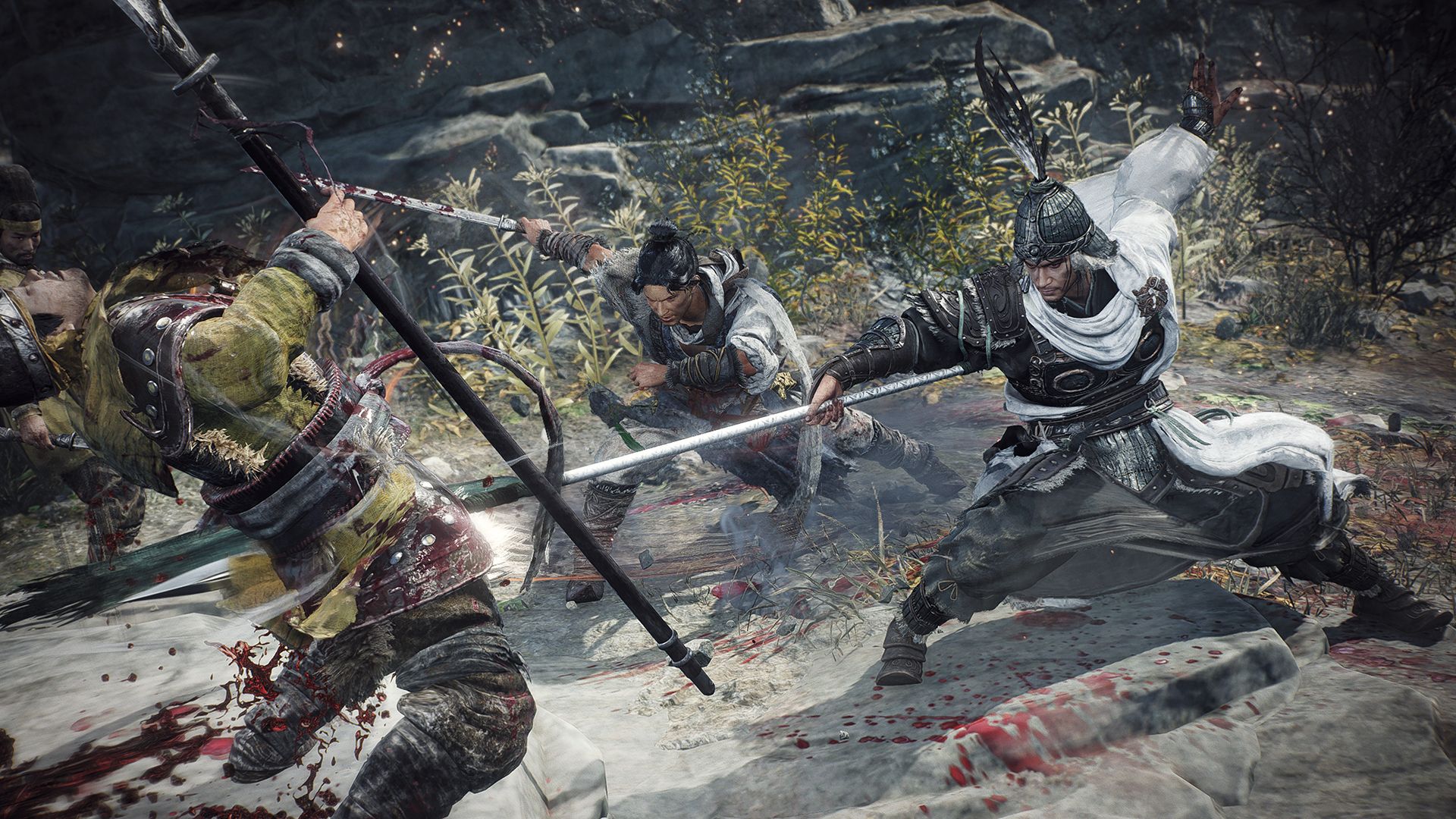
Buckle up, Soulslike fans, there’s a brand new game and possibly a brand new series vying for your attention and masochistic tendencies. It’s Wo Long: Fallen Dynasty, the newest third-person action RPG coming from Team Ninja, a studio known for making no-nonsense, skill-based action games as far back as 2003’s Ninja Gaiden. Like previous works of Team Ninja, this one will also be difficult for newcomers or those uninitiated in the ways of Soulslikes. However, veteran players will probably find Wo Long to be a breeze.
After a short intro and a pretty decent character creator, players are dropped into a version of China that is in peril during the late Han dynasty. Blood in the streets, villages reduced to smoldering embers, and demonic creatures prowling the wreckage has become commonplace. Players take on the role of a soldier who falls in battle, only to be mysteriously revived by a powerful magic item in typical Soulslike fashion. That item and its significance are explained through the story that is presented through the occasional cutscene. Unfortunately, the story is also pretty messy and not very well-written. It does serve just fine as a means of ushering players from one level into the next, though.
"Combat in Wo Long is fast-paced, and it’ll definitely punish green players repeatedly for not taking stronger enemies seriously and paying attention to enemy patterns, which are all well-animated and appropriately telegraphed."
From a glance, Wo Long seems like it’s taking after Team Ninja’s Nioh series, utilizing similar gameplay mechanics and a fictionalized, pseudo-historical setting that is amplified with plenty of demonic and supernatural entities to spice things up. Others have also compared it to Sekiro from early gameplay demos. However, while Wo Long does have some things in common with these games, with a little mastery of its core defensive function it might feel closer to a standard action game for its target demographic.
Combat in Wo Long is fast-paced, and it’ll definitely punish green players repeatedly for not taking stronger enemies seriously and paying attention to enemy patterns, which are all well-animated and appropriately telegraphed. The enemies themselves are also inventive and cool, and might even give other Soulslike games a run for their money in terms of monstrous creatures.
There are thirteen weapon types to use which run the gamut from swords and spears to heavier weapons like hammers, and even ranged options like bows. These weapons scale based on the virtues you dedicate upgrade points to, which also determines what type of build your character has. Each weapon also has a unique moveset and special attack. All of these things are pretty common for Soulslikes, but Wo Long lacks the mechanical depth in melee combat that other games have, namely Sekiro.
There is a parry/reversal system that looks awesome and feels great to use, but that’s really it in terms of defensive maneuvers. There’s no need to account for different types of unstoppable power attacks because you only need one button to deflect everything, even normal moves. There is a block that is tied to a posture system that gets depleted and can eventually break, but there’s no real incentive to use it unless you build your character around blocking.
However, there is a magic system that introduces a level of strategy for certain fights. Magic in Wo Long is based on the five elements, or “phases”, and can be used to counter enemy attacks of the opposite phase. Mixing in magic with the flashy melee combat and deflection maneuvers was a little too much for me to keep track of, but it seems well-designed enough that veteran Soulslike players could revel in it when it is a viable option.
"Mixing in magic with the flashy melee combat and deflection maneuvers was a little too much for me to keep track of, but it seems well-designed enough that veteran Soulslike players could revel in it when it is a viable option."
While you might go into Wo Long being extra careful, the parry/deflection-focused melee combat that makes up a majority of the game quickly boils down to pressing the deflect button to gain the upper hand and putting enemies down. It’s still fun, and it creates more than a few moments of extreme hype with slick animations, but there’s no real depth to combat beyond that in most fights. Well, there is an AI companion system that allows you to bring up to two warriors with you who get stronger the more you use them, but the friendly AI is not very useful outside of being a distraction for enemies in most cases.
Instead of a large, open world, Wo Long features several linear levels with side paths and shortcuts that lead to a boss character at the end. There’s enough visual variety in these locations to be moderately interesting, but the level design of each place is not up to par with similar games, mostly due to that linearity. There are diversions and distractions to mask it, but each stage is almost a straight line, and doesn’t take that long to traverse if you can get around enemies.
One of the interesting things that Wo Long brings to the table is the morale system. Every enemy as well as the player character has a number set within a colored circle, which denotes their morale level. Enemies with higher morale will be tougher to take down and could possibly one-shot you, but every kill you get upgrades your own morale and makes you effectively more powerful. This stat decreases upon death, but there are several Marking Flag locations that allow you to raise a flag to lock in a certain morale level, up to a maximum of 20 if you’re able to find all of them. These Marking Flag spots look similar to Battle Flag posts, but the latter act as your bonfire/respawn point.
You could look at the morale system as a method of forcing a “grind” in order to be powerful enough to take on a boss, and it can become that if you miss a few Marking Flag posts, but it doesn’t seem to be intended that way. The morale system instead feels more like a way of encouraging players to explore every nook and cranny of every level (which isn’t hard given the aforementioned linearity), and take down every enemy you find, including powerful sub-bosses. Those with enough skill will probably be able to bypass this system entirely, so it also seems to be in place to help more casual players get through levels.
"Wo Long: Fallen Dynasty is a fun Soulslike that, while still providing a challenge, will be a breeze for seasoned Soulslike players."
In the midst of exploring locations and doing battle with human and monster foes, I noticed a particularly frustrating issue. Sometimes, inputs just wouldn’t register. The first few times my character ignored my plea to use a healing item in the middle of combat, I thought it might have been my PS5 controller. I’ve tested it with other games, but it seems to only be Wo Long. I don’t know if this is a widespread issue or not, but it definitely added to my stacks of legitimate deaths with ones that felt unfair. Especially when a deflect input didn’t go through.
There is also a massive focus on loot and gear, which creates a problem that was also present in Nioh- equipment management. Inventory screens are just a jumble of numbers and minor percentages that don’t really affect gameplay that much from what I could tell, and only serves to confuse and overwhelm. If you like micromanaging stats down to the smallest percentage, you’ll love it, but I opted to pick the largest numbers and dump everything else.
Ultimately, Wo Long: Fallen Dynasty is a fun Soulslike that, while still providing a challenge, will be a breeze for seasoned Soulslike players.
This game was reviewed on the PlayStation 5.
Flashy deflection system; Morale mechanic encourages exploration and offers a leg-up to less-skilled players; Awesome enemies with well-animated attack patterns.
Combat boils down to deflecting/parrying; Companion AI is not great most of the time; Semi-frequent dropped controller inputs.



















